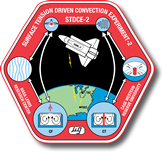STDCE-2
Surface Tension Driven Convection Experiment – 2 (STDCE-2)
Overview
 On earth, fluid convection is dominantly dictated by buoyancy and thermocapillary forces are reduced. These thermocapillary forces are caused by temperature-induced surface tension variations that are not easily studied where gravity is strong. Only in very small settings on earth can thermocapillary action be measured, thus creating limited experiments covering limited parameters. Thermocapillary forces are also known to cause oscillatory motion on earth under specific conditions. On earth, studies have shown correlation between surface tension gradient driven flow oscillation and the Marangoni number of the fluid.
On earth, fluid convection is dominantly dictated by buoyancy and thermocapillary forces are reduced. These thermocapillary forces are caused by temperature-induced surface tension variations that are not easily studied where gravity is strong. Only in very small settings on earth can thermocapillary action be measured, thus creating limited experiments covering limited parameters. Thermocapillary forces are also known to cause oscillatory motion on earth under specific conditions. On earth, studies have shown correlation between surface tension gradient driven flow oscillation and the Marangoni number of the fluid.
The Marangoni number is a dimensionless measure of the energy of the thermocapillary flow to that due to heat conduction. It also compares the strength of the surface tension driven flow to the viscosity driven flow. Areas of the fluid adjacent to the interface with low surface tension move to areas of high surface tension.
STDCE-2 was a fluid physics experiment that studied thermocapillary flow in microgravity. It was a revised experiment after the results of STDCE-1, where thermocapillary flow was found not rely solely on the Marangoni number. STDCE-2 factored in an additional parameter, multiple cylinders of smaller volume, and more total tests.
Experiment Operations
The experiment comprised of a cylinder filled with 2 centistoke silicone oil that was heated in two distinct experiments: constant flux (CF) and constant temperature (CT). CF contained a CO2 laser pointed at the center of the oil to heat it up, while CT had a heating device in the center of the cylinder and oil. In both cases, the heating device caused a surface temperature gradient on the surface of the oil, leading to oscillatory motion. The cylinder wall contained nine thermistors that measured temperature of the chamber at nine points. A camera, IR imager, and a Ronchi system were used to record data for the experiment, and was later analyzed after landing.
The primary controlled variable in both CF and CT was the difference in temperature between the cylinder wall and the heating device. For CT, the heater temperature was easily recorded, but for CF numerical analysis involving the laser power and beam diameter were required to get the desired quantity. In both cases, the temperature difference was used to calculate the Marangoni number of the fluid at times throughout the experiment.
Results
Furthering our understanding of fluid forces helps science to better predict fluid motion. Surface tension is the dominant fluid force in space, so the behavior it causes under specific conditions is critical in our knowledge of fluids physics in space.
The main change from STDCE-1 was the addition of an additional parameter taken into consideration for causing oscillatory flow. This was named the S-parameter and represents the ratio of free surface deformation to in the heated region to the thermal boundary layer thickness. The S parameter was controlled by changing the Marangoni number and the volume of oil used in the given trial.
Image Gallery
Management
Principal Investigator: Simon Ostrach, Case Western Reserve University, Cleveland, Ohio
Co-Investigator: Yasuhiro Kamotani, Case Western Reserve University, Cleveland, Ohio
Project Scientist: Alex Pline, NASA Glenn Research Center, Cleveland, Ohio
Project Manager: Thomas Jacobson, NASA Glenn Research Center, Cleveland, Ohio
For more information, contact Nancy Hall at nancy.r.hall@nasa.gov


